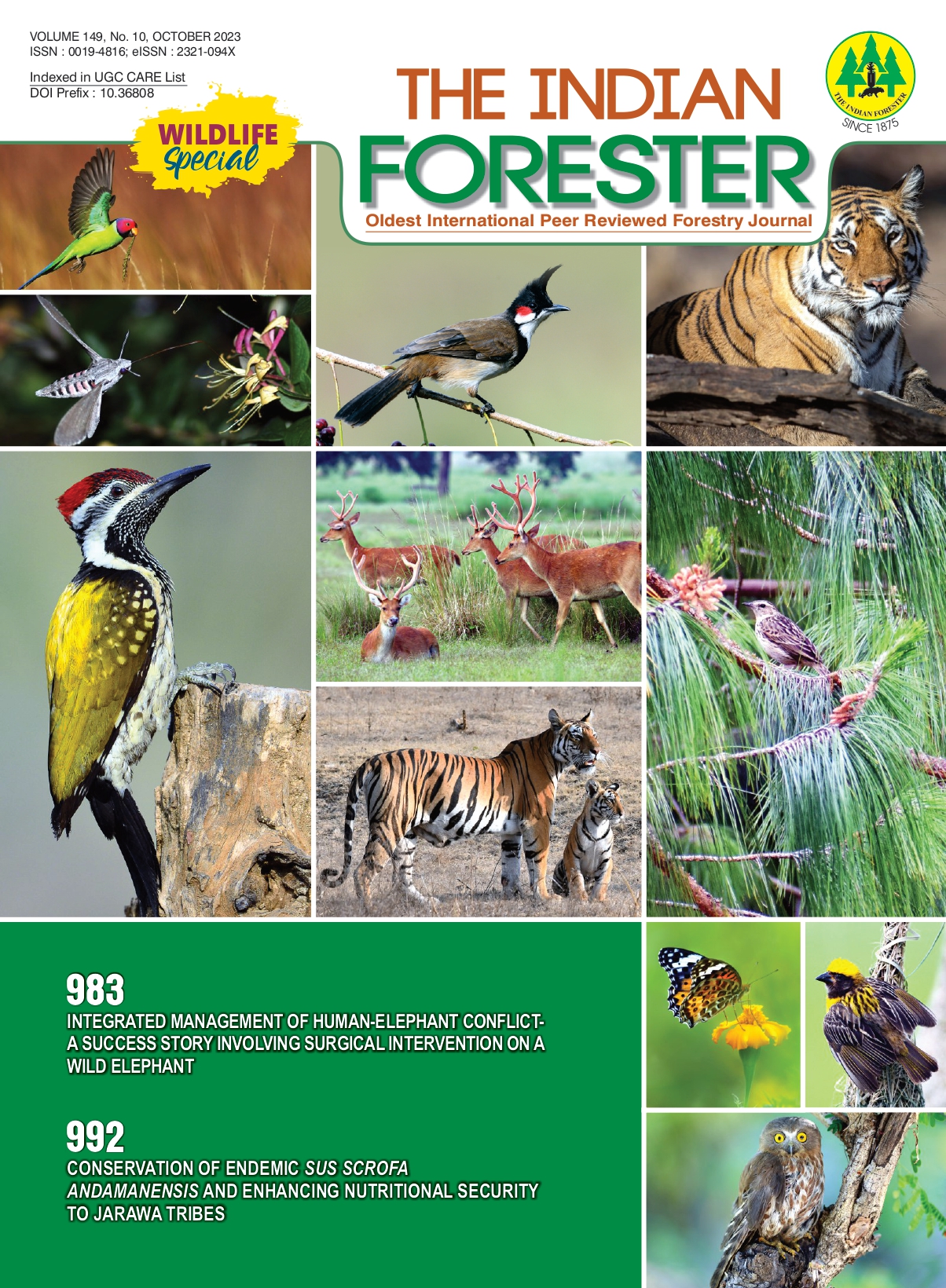Reptiles Fatality Records during Grassland Burning: A Short Note from Orang National Park, Assam, India
DOI:
https://doi.org/10.36808/if/2023/v149i10/168179Keywords:
Tricarinate Turtle, Annual Grassland Burning, Prescribe Block Burning.Abstract
The study records the death of reptiles during grassland burning in Orang National Park, Assam. The survey also reveals that both slow-moving animals like chelonian species along with fast-moving reptiles like Bengal Monitor are killed during annual grassland burning. The survey was conducted in the Orang National Park, Assam after the annual grassland burning in March 2021. Authors recorded the 20 Noun Carrion belonging to two species: Tricarinate Turtle and Bengal Monitor. Grassland burning is an important tool for habitat management, but unscientific grassland burning is detrimental to grassland management as well as slow-moving lower vertebrates. Prescribe block burning is critical for sustainable grassland biodiversity management.References
Banerjee S., Das D. and John R. (2021). Grassland vegetation and roads have dominant influence on decadal-scale spatial-temporal patterns of fires in a species-rich protected Terai habitat in northeastern India, Agricultural and Forest Meteorology, 304: 108411.
Bhattarai P. (2012). Threats on Grassland Ecosystem Services: A Case from Shuklaphanta Wildlife Reserve, Nepal Journal of Science and Technology, 13(2): 159-166
Carlier L., Rotar I., Vlahova M. and Vidican R. (2009). Importance and Functions of Grasslands, Notulae Botanicae Horti Agrobotanici Cluj-Napoca, 37(1): 25-30
Chandran M. (2015). Grassland Vegetation of India: An update. In G.S. Rawat and B.S. Adhikari (Eds), Ecology and Management of Grassland Habitats in India, ENVIS Bulletin: Wildlife and Protected Areas, Wildlife Institute of India, Dehradun-248001, India, 17: 240.
Chakdar B., Singha H. and Choudhury M.R. (2019). Bird community of Rajiv Gandhi Orang National Park, Assam, Journal of Asia-Pacific Biodiversity, 12(4): 498-507.
Choudhury M.R., Deb P. and Singha H. (2017). Status of Invasive Plant Species in the Dry Savanna Grasslands of Rajib Gandhi Orang National Park, Assam, International Journal of Ecology and Environmental Sciences, 43(3): 245-250.
Debroy S. (1986). Fire in tall grassland habitats of Assam, Indian Forester, 112(10): 414–418.
Debroy S. (1991). Manas – Monograph, Tiger paper, 18(1): 10.
Deka B. and Saikia P.K. (2015). Diversity of Chelonian Species in Orang National Park, Assam, Journal of Global Biosciences, 4(5): 2150-2167.
Fogarty D.T., Roberts C.P., Uden D.R., Donovan V.M., Allen C.R., Naugle D.E., Jones M.O., Allred B.W. and Twidwell D. (2020). Woody Plant Encroachment and the Sustainability of Priority Conservation Areas, Sustainability, 12: 8321; doi:10.3390/su12208321.
Ghosh S. (2015). Drivers of Change–Ageospatial study on fires in Terai Grasslands of Manas Tiger Reserve and World Heritage Site, India, Ecology and Management of Grassland Habitats in India, ENVIS Bulletin: Wildlife & Protected Areas, 17: 180-189.
Johnson A.S. and Hale P.E. (2002). The Historical Foundations of Prescribed Burning for Wildlife: a Southeastern Perspective, Northeastern Research Station, pp. 11-23.
Kumar H., Mathur P.K., J.F. Lehmkuhl, D.V.S. Khati, R. De and Longwah W. (2002). Management of Forests in India for Biological Diversity and Forests Productivity, A New Perspective - Volume VI:, Terai Conservation Area (TCA). WII-USDA Forest Service Collaborative Project Report, Wildlife Institute of India, Dehra Dun. 158 pp.
Lahkar B.P. (2008). Ecology and management of grassland with special reference to grass and bird communities in Manas national park Assam, Ph.D. thesis, Gauhati University, chapter 7, pp: 131-169.
Landsberg J.D. and Lehmkuhl J.F. (1995). Tigers, rhinos and fire management in India, Proceedings on fire effects on rare and endangered species and habitats. International Association for Wildl and Fire, Moscow, Idaho, USA, 101-107.
QGIS Development Team (2020). QGIS Geographic Information System. Open Source Geospatial Foundation Project. http://qgis.osgeo.org.
Rodgers W.A. (1986). The role of fire in the management of wildlife habitats: a review, Indian Forester, 112(10): 845-857.
Vogl R.J. (1967). Control Burning for wildlife in Wisconsin, Proceedings of the 6th annual Tall Timbers Fire Ecology Conference; 76-109.
Downloads
Downloads
Published
How to Cite
Issue
Section
License
Unless otherwise stated, copyright or similar rights in all materials presented on the site, including graphical images, are owned by Indian Forester.





